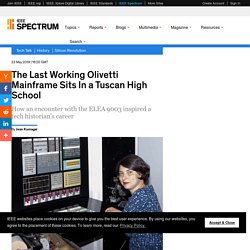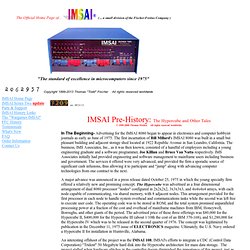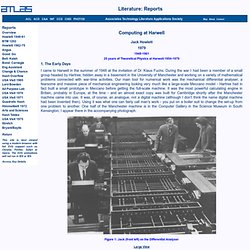

The Last Working Olivetti Mainframe Sits In a Tuscan High School. About 10 years ago, Elisabetta Mori and some friends were doing research for an art exhibit on the theme of “archives of memories.”

“We approached the theme literally, and so we looked for old examples of physical memories—computer memories,” Mori recalls. “We tried to see the oldest computers built in Italy.” At the Museum of Computing Machinery in Pisa, they saw the Calcolatrice Elettronica Pisana, an early digital computer built by the University of Pisa in 1957 with the support of the Olivetti company. But the machine had long ago stopped working. Then they heard about a working model of the ELEA 9003, Olivetti’s first commercial mainframe, introduced in 1959. This 9003 had originally belonged to a bank in Siena, where it was used for payroll, managing accounts, calculating interest rates, and the like. The mainframe’s sleek aluminum modular racks and peripherals occupy a large room, with Olivetti typewriters and calculators spread around the space. Manchester Baby Computer.
Mark 1 Story : Introduction, The Baby, Manchester Mark 1, Ferranti Mark 1Current Page : Background, Specification, End of Page (Links) Are you interested in helping to maintain and demonstrate the Replica Baby machine?

Background The world's first stored-program electronic digital computer successfully executed its first program on 21st June 1948. That program was written by Tom Kilburn who, along with the late F.C. (Freddie) Williams designed and built the machine. Freddie Williams started work in July 1946 on a form of digital storage using a Cathode Ray Tube, at the Telecommunications Research Establishment (TRE) at Malvern. In December 1946 Freddie Williams moved to the University of Manchester to take up a chair in Electro-Technics. Though the store could remember 2048 bits, an individual bit could only be reset by hand, and it was necessary to test its capability of setting and reading any required bit at electronic speeds and remembering its value indefinitely between settings. Vintage Computer Advertisements from the late 1970s. Sperry-Rand NWO Technology History - The RR. When PCs Were Micros - The Early Days of Microcomputing.
IMSAI. THE HISTORY OF IMSAI- The Path to Excellence SummaryIMSAI Manufacturing Corporation, a leading manufacturer of microcomputer systems and components, specializes in the small business and hobby market.

Located in San Leandro, California, IMSAI developed and shipped its first product, the I-8080 Microcomputer, in 1975. The versatile l-8080 satisfied the limited needs of the hobbyist as well as the extended needs of commercial users. The sustained success of this initial product has enabled IMSAI to expand its product line. Today, after developing small business computers with a price tag low enough to be used by businesses with limited budgets, IMSAI has the broadest range of products offered in the microcomputer market, IMSAI was the first in the industry to design and manufacture a fully integrated system.
In the l973, William H. Before he founded IMS Associates, Bill Millard had held management positions in finance and industry. Initially IMS products were marketed by mail order. Old Computers - rare, vintage, and obsolete computers. Computing at Harwell. Computing at Harwell Jack Howlett 25 years of Theoretical Physics at Harwell:1954-1979 1.

The Early Days I came to Harwell in the summer of 1948 at the invitation of Dr. Large View We - meaning Hartree's group - had done what at the time was rated a large-scale calculation for Fuchs and Peierls, concerned with the atomic bomb project. Computing then was a completely different world from what it is now. Computational services were needed all over the Establishment, these needs were going to grow rapidly and what was wanted was a service available to everyone. It may seem strange today that an enterprise so large and so technologically and scientifically sophisticated should have been planned without a central computing service, but remember, this was 30 years ago and the power and all-pervading nature of computation could not possibly have been realised at the time.
This was before the U.K.A.E.A. had been created, when Harwell was still part of the Ministry of Supply. 2. Large View Large View. Natura.